
Staff of the Primus

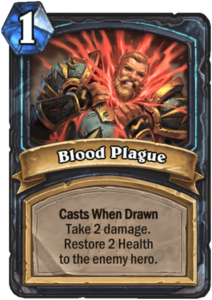
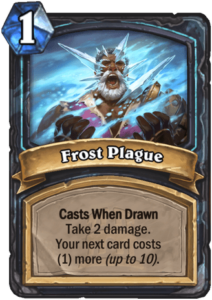
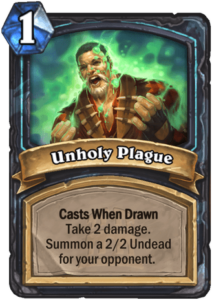
This weapon is underwhelming in terms of immediate board impact and damage. A 1/3 weapon for 1 mana is worse than Light’s Justice, an unplayable card. The benefit of Staff of the Primus is long term, as it’s eventually worth 6 damage through three plagues, on top of their additional benefits.
This card fits a slower strategy much more than it complements a faster one. Even though it can technically be added to Unholy-Aggro DK, the Plague package seems to be promoting a slower Unholy deck, stylistically akin to Bomb Warrior or Curse Warlock, one that possesses late game inevitability and looks to slowly bleed the opponent dry. Playing this card in a faster deck means you’re not going to consistently get its full benefits. If you do, the game has likely dragged on too long for your deck’s comfort.
Score: 2
Northern Navigation

In theory, Thrive of the Shadows with a small bonus effect to a deck utilizing Frost spells sounds like a good enough constructed card. However, Frost-Aggro DK is very particular about the spell package it wants to run and can already soft tutor them through Overseer Frigidara. Northern Navigation doesn’t do much to further that deck’s game plan, as spending 2 mana on a discover effect is quite slow. Should a slower Frost deck emerge, one that runs Deathchiller, it might be interested. Otherwise, this is just a spell you’ll occasionally generate with Vizier or Teacher.
Score: 1
Eulogizer

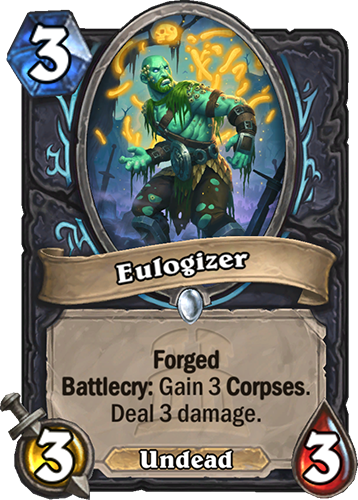
This minion’s unforged form is very weak on curve, as you’re extremely unlikely to generate enough corpses to activate it. This means you must forge it on turn 2, in which case it becomes a decent play on turn 3. But spending 5 mana in the early game to deal 3 damage and summon a 3/3 minion doesn’t sound too great. There is no Death Knight deck that’s particularly desperate to generate corpses in the early game beyond its passive board development. In many ways, this card is weaker than the neutral Cyclopian Crusher because Crusher’s baseline form is stronger. Eulogizer doesn’t seem to move the needle for any Death Knight strategy.
Score: 1
Down with the Ship

This spell is painfully conditional. It deals 3 damage to a minion, so it cannot go face. Only if that minion dies, does it provide the benefit of plague shuffling. The rune requirement also means that it’s essentially locked out of being played in any other established Death Knight deck. Not that they’d want this card! Down with the Ship only makes sense in a dedicated Plague DK deck, one that looks to maximize the potential inevitability of the plagues. If this archetype doesn’t materialize, this removal spell will not see play.
Score: 2
Frozen Over

Frozen Over is an upgraded Research Project, an old Mage spell from The Boomsday Project that saw fringe play in extreme combo strategies. The fact that your opponent can’t play the spells they draw from this card the next turn is a disruption bonus that theoretically makes it more tolerable for you to spend mana giving them cards.
But still, you really don’t want to give your opponent cards. Beyond funny milling strategies, we can’t see this card being a good idea in a ‘normal’ Death Knight deck. Research Project required extreme defensive tools and extreme mana reduction effects to see constructed play. Beyond Frostwyrm’s Fury, Death Knight excels at neither of these things.
Furthermore, running this card in Plague DK so that your opponent draws their plagues more quickly carries diminishing returns. If they draw a plague from Frozen Over, the penalty does not apply to the card they draw after the plague effect resolves. We can do better.
Score: 1
Tomb Traitor

Tomb Traitor spends one of the plagues you’ve shuffled to the opponent’s deck to produce a powerful AOE effect. A 4 mana 4/3 that deals 3 damage to enemy minions is better than Duskbreaker. As such, its restriction is much more limiting, only realistically fitting in a dedicated Plague DK deck that is locked into two Unholy runes and one Frost. It also requires you to draw a plague card early, so activating it on curve is not a guarantee.
Traitor gives Plague DK the best chance of materializing as a competitive deck, as it provides it with a strong defensive swing. It is important that the archetype has access to survivability since it looks to draw out the game and cannot tap into the defensive tools available with Blood runes. What we don’t love about these cards is that they live and die with the package.
Score: 2
Distressed Kvaldir

A Bloodfen Raptor with a plague related deathrattle. Since the effect is a deathrattle, it is quite slow. Much like Staff of the Primus, Unholy-Aggro DK can technically run this card, but a vanilla minion with a slow benefit doesn’t seem like a great piece in a deck that highly prioritizes winning early board control to succeed. Any sort of speculation about utilizing it with Yelling Yodeler is coping of the highest degree. Kvaldir should be a decent early game minion for Plague DK, helping it activate Traitor on curve, but we don’t expect it to do more than that.
Score: 2
Chained Guardian

Chained Guardian gives Plague DK some pseudo-single target removal. If you can discount it quickly enough, it can deal with two large threats in one turn. It is also quite a threat by itself, having 8-attack and a sticky reborn keyword that makes it quite annoying to remove. However, reducing its cost is no easy feat. You’re pretty much required to invest deck slots into the entire Plague package to consistently discount it. Staff of the Primus, Down with The Ship, Distressed Kvaldir and Helya through turns 1-4 means Guardian costs 1 mana. That’s obviously a best-case scenario, so it tells you that plague density is critical for Guardian to be active in the mid-game. It’s a good card for a very specific deck.
Score: 2
Helya

Once you play Helya, your plagues start behaving like Hakkar’s Corrupted Blood. If your opponent draws a plague, its ability is triggered, and then it shuffles back into the deck after the draw phase resolves. This means that Helya is a standalone win condition for potentially infinite damage. If your opponent gets close to the end of their deck with a notable number of unending plagues, they’re going to die very quickly. Of course, relying on your opponent to get to that stage of the game isn’t the way to win every matchup, but it does mean that Plague DK possesses a late game clock. If you can keep surviving, time works in your favor. Those plagues will continue to heal you, summon zombies for you and disrupt your opponent’s ability to spend mana on cards.
Helya is the cornerstone card for Plague DK, one that makes it want to invest in as much survivability as possible. It would have been a great card for Blood-Ctrl DK, but its rune restriction means such an addition isn’t possible. As a 4 mana 4/4, we’re not enamored with the idea of putting it in Unholy-Aggro DK.
Score: 2
The Primus


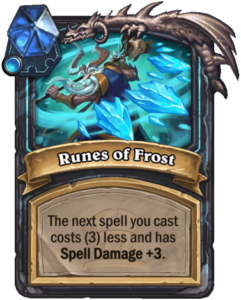
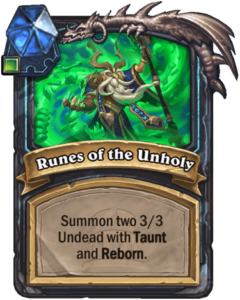
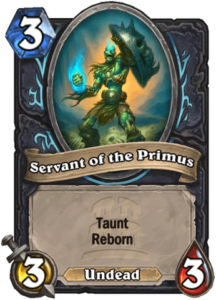
The Primus is a powerhouse TITAN available to all Death Knight decks, with appropriately named abilities that synergize with their signature traits. In addition, when the Primus casts an ability, you discover a card from that rune type, meaning that it’s a snowballing value generator that your opponent will not want to see survive for long.
The Primus’ most important ability, one that guarantees its flexibility in multiple Death Knight decks, should be Runes of Blood. Upon entrance, you can destroy an opponent’s minion, buff the Primus’ health to make it more difficult to remove, and heal yourself too. This is an amazing ability to cleanly deal with other TITANS, which are likely to be very popular in the format.
Runes of Frost makes Howling Blast a very intriguing option in Frost-Aggro Death Knight, as you can immediately cast it alongside the Primus to devastate your opponent’s board. Its utilization isn’t as strong in other Death Knight decks, though Blood-Ctrl DK does have some removal spells that can benefit from Spell Damage, such as Death Strike.
Runes of Unholy is a solid choice that produces a strong board with sticky taunts that protect both The Primus and the Death Knight. Much like Runes of Blood, this ability enhances The Primus’ likelihood of sticking for another turn, allowing you to cast another powerful ability while discovering a card. It’s also the strongest option to develop the TITAN into an empty board, making it useful not just as a responsive tool, but a proactive one.
Overall, it’s hard to see any Death Knight deck passing on this legendary. It’s far too flexible of a top end card and a strong answer to other TITANS. Runes of Blood and Unholy are abilities that any deck can appreciate, while the discover value is significant. If The Primus lives to cast its third ability, the game is likely over already.
Score: 4
Final Thoughts
TITANS Set Rank: 8th
Overall Power Ranking: 9th
Death Knight has been the most popular class for most of the time since its launch in March of the Lich King. Team 5 has successfully defined its three major archetypes and their unique characteristics behind powerful triple rune payoff cards. There has been no major deviation from those strategies. The TITANS’ set looks like the most serious attempt to introduce a new archetype that is not built with three identical runes. Let’s be real, the Rainbow thing never had a chance.
Can Plague DK be successful? While the strategy looks fleshed out, our impression is that it will not match up well into the upcoming format. Plague DK looks to win an attrition battle by bleeding out their opponents over a long period of time. While the plagues can be disruptive, they are mostly irritants. The damage they deal doesn’t register early enough to be a serious threat to decks that power spike before turn 10. The other issue is that Plague DK doesn’t have great survivability tools to outlast high inevitabily win conditions. It’s got decent early game AOE removal and some single target removal, but it doesn’t have anywhere close to the removal plethora available to a Blood-Ctrl DK or a Control Priest. It needs to “Bomb Warrior” opponents into submission. So, our expectation is that it will… bomb.
Should this transpire, the established Death Knight decks are left with not much to upgrade on their current tools. This set is all-in on Plague DK and little else.
Blood-Ctrl DK may struggle to match up to a high lethality format. The deck has always been a sitting duck to strategies carrying strong inevitability, and our expectations is that these strategies will increase in their prevalence and power. The Primus is an excellent card for the archetype, but it needs more than that. It needs a way to pressure opponents in the late game and shake them off their game plan.
Unholy-Aggro DK is likely to get baited into a plague package. We have little faith that a fast-paced strategy that is reliant on seizing board control and leveraging its control to win through a board-based finisher, will excel by playing cards that do the opposite.
The counter argument is that plague cards provide disruption and off-board damage, but neither of these are reliable in a short time window. Plague cards sacrifice board impact and stats for a slow payoff that doesn’t come online before most of Unholy games’ outcomes are already determined. We’re more interested to see whether an Egg/Yodeler build can beat the established variant thanks to the addition of Ravenous Kraken.
Frost-Aggro DK is in danger of getting old, as the strategy has barely changed for months. The Primus could give it another late game bite, but what you currently see from the archetype is most of what you’re going to get in TITANS. Can it overcome the increased power level from the rest of the field with its big freeze?
Death Knight is blessed with multiple established strategies, so something should be able to work. But we can’t help but feel a sense of staleness creeping into the class.

Just like Starfox says: Thank you zacho! You really make it possible for me to enjoy this game in its full potential!
>If your opponent has a big threat on the board, Golganneth takes care of it.
Not if it has divine shield 🤣
Thx for the good work!
I always enjoy reading your stuff!
Thanks for the review. I appreciate your work. Good luck with the launch!
Of course it’s good with Implock; it’s an IMPrisoned Horror.
I don’t often see many comments on here, so I’ll just say thank you for all of your hard work on this. Not only are you analyzing every card and it’s possibilities, but you’re doing detailed write ups on the potential of each card. Every pre-expansion I look forward to this preview and it never disappoints!
first